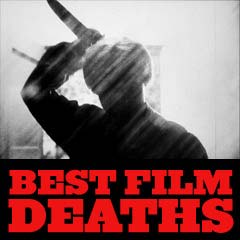
|
Deaths Scenes 1950-1952 |

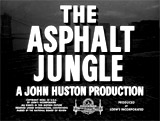
|
In the final downbeat sequence, an ironic conclusion following the commissioner's speech about police pursuit for a "hardened killer," bleeding and dying Dix Handley (Sterling Hayden) - after a failed heist - drove furiously with Doll Conovan (Jean Hagen) to his beloved Kentucky homeland to fulfill his last obsession - his lost childhood dream. Hallucinating with memories of the simple life he once experienced at the farm, he mumbled to himself as it approached, signaled by long rows of white fences. Under the bright, sunny sky, he staggered from his car into a bluegrass field just outside his family's Kentucky Hickory Wood Farm. In the lyrical ending, he fell down exhausted and expired from his bleeding wound in the grass of the meadow-pasture, amidst four grazing and nuzzling colts he had dreamed of owning. |
   Death in Kentucky Bluegrass Field |
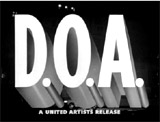
|
D.O.A. (1950) This classic noir detective story was remade as Color Me Dead (1969, Australia) and as D.O.A. (1988), starring Dennis Quaid and Meg Ryan in a completely-revised story. Its main premise was also the basis for the action thriller Crank (2006). It opened with an unlikely and innovative shocking premise -- the protagonist hero, a tax accountant-notary public named Frank Bigelow (Edmond O'Brien), was already dead. Filmed with a lengthy tracking shot, Bigelow entered a Los Angeles police station, walked to the Homicide Division, and told the Captain (Roy Engel) in charge: "I want to report a murder" - and when asked about where, when and who was murdered, he replied: "In San Francisco, last night...I was." In flashback, he described how he had been slowly "murdered" after having his drink in a San Francisco jazz or "jive" night-club swapped with a lethal dose of glow-in-the-dark "luminous toxin" (radiation poisoning by iridium). The remainder of the film was an investigation by the doomed and dying man (with only a few days to live) into why he was lethally poisoned. The story (told in flashback) returned to the police station, where Bigelow finished describing how he had just solved his own murder case:
Then as he struggled to his feet, leaned on the Captain's desk, and uttered his last words (referencing his secretary-girlfriend "Would you...Paula"), he fell dead to the floor. The police captain responded to a question about making out the Missing Persons report on him:
In a close-up before the end credits, Bigelow's Missing Persons report was stamped: D.O.A. |
 Bigelow: ""All I did was notarize a bill of sale..."  Bigelow's Last Word: "Paula..." Before Collapsing Dead  The Captain Responded to Deputy: "Better make it 'Dead on Arrival'"  Missing Persons Report Stamped D.O.A. |
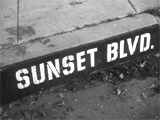
|
Sunset Boulevard (1950) (aka Sunset Blvd.) The first scene showed motorcycle officers followed by police cars with sirens blaring rushing to a mansion in Beverly Hills. There, they found a dead body floating face down in a swimming pool. Detectives tried to fish the corpse out of the water. A voice-over narration was read cynically and crisply with a film-noirish style - it was startling because it was the corpse speaking:
The dead person, hack writer Joe Gillis (William Holden) provided the reason why he was killed in the film's story, seen in flashback. |
   Homicide Victim Joe Gillis (William Holden) Dead in Swimming Pool Narrating His Own Death |

|
Ace in the Hole (1951) (aka The Big Carnival) In a final low-angled shot, bleeding, defeated journalist Charles "Chuck" Tatum (Kirk Douglas) collapsed at the feet of his newspaper editor Mr. Boot (Porter Hall):
|
 Tatum's Collapse Face-First 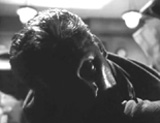 Tatum Falling Dead: "You can have me for nothing" |
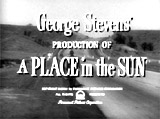
|
In a dramatic, mysterious scene, the pregnant girlfriend Alice Tripp (Shelley Winters) of George Eastman (Montgomery Clift) was rowboating with him at Loon Lake. He had planned a holiday outing with Alice - in actuality, it was his elaborate plan to go to a lodge at the deserted Loon Lake, rent a rowboat, and then push Alice overboard and drown her, so that he could be with his real love, Angela Vickers (Elizabeth Taylor). George slowly rowed to a deserted, darker part of the lake (he'd been told "You've got it all to yourself"). Filled with indecision and inner, debating turmoil, he showed the pressure, strain, and sweat on his face in the climactic, menacing scene. She rambled on about how happy they would be in their future marriage - with a child. The eerie sound of a loon was heard. At the last crucial moment, he realized that he could not bring himself to carry out his murderous evil plan ("I'll make it up to you. I'll stick by you").. Alice attempted to comfort George - seeing the compassionate yet strained anxiety within him. The pitiful and pregnant Alice told him she wouldn't complain about being penniless and poor in their quiet and loveless marriage - she sensed how George felt about marrying her:
Her words were aggravating to George, and he yelled out for her to "Stop it!" Then, she foreshadowed her own death:
When she stood up to embrace him and console him ("Oh, poor George. I know it isn't easy for you. I shouldn't have said that"), in an ironic turn, she unbalanced the boat and caused it to rock and capsize. Things happened very quickly - they both fell in at the same time. The scene ended in a very long shot of the overturned rowboat, and transitioned to a dark, blurry dissolve into the next scene. Off-screen, Alice had accidentally drowned. It was unclear whether George hesitated too long and maybe could have saved her. Was he responsible for her death? |
    Rowboat "Accident"?  Overturned Rowboat |

|
The premise of Hitchcock's film was the proposed swapping (or exchange) of murders by two 'strangers on a train' who met and planned the homicides so that there would be no witnesses:
The first murder (committed by Bruno) was of Guy's vulgar and promiscuous wife Miriam (Laura Elliott). Guy had expressed a desire to divorce Miriam (pregnant by another man), but she had refused. His intention was to enter politics and marry Senator's daughter Anne Morton (Ruth Roman), to leave the world of pro tennis and enter politics. At an amusement park, after Bruno had stalked Miriam and two boyfriends into a tunnel-of-love ride, he carried out the homicide. On a nearby island dubbed the "Magic Isle," Miriam's shocking strangulation murder scene was reflected or mirrored in her thick-lensed glasses that had fallen to the grass. In the distant background, the merry-go-round calliope ironically played "And the Band Played On." |
 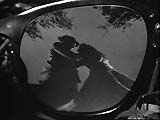 Miriam's Reflected Murderous Strangulation |
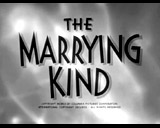
|
The Marrying Kind (1952) During a family picnic scene, Joey (Barry Curtis, uncredited), the six-year-old son of bickering, unhappily-married couple Florence "Florrie" (Judy Holliday) and Chet Keefer (Aldo Ray), accidentally and tragically drowned in a park pond. At the same time, an oblivious Florrie (with a ukulele) was strumming and singing "How I Love the Kisses of Dolores" to her husband. |
 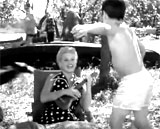  Joey's Tragic Drowning |
(chronological by film title) Intro | 1915-1929 | 1930-1933 | 1934-1938 | 1939 | 1940-1942 | 1943-1945 | 1946-1947 | 1948-1949 1950-1952 | 1953-1955 | 1956-1957 | 1958-1959 1960-1961 | 1962-1963 | 1964-1966 | 1967-1968 | 1969-1970 1971 | 1972 | 1973 | 1974 | 1975 | 1976 | 1977-1978 | 1979 1980 | 1981 | 1982 | 1983 | 1984 | 1985 | 1986 | 1987 | 1987 | 1988 | 1989 1990 | 1991 | 1992 | 1993 | 1994 | 1994 | 1995 | 1995 | 1996 | 1997 | 1998 | 1998 | 1999 2000-2001 | 2002 | 2003 | 2004 | 2005 | 2006 | 2007 | 2008 | 2009 | 2010 | 2011 |